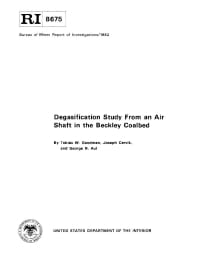Mining Publication: Degasification Study From an Air Shaft in the Beckley Coalbed
Original creation date: January 1982
Authors: TW Goodman, J Cervik, GN Aul
NIOSHTIC2 Number: 10002392
Pittsburgh, PA: U.S. Department of the Interior, Bureau of Mines, RI 8675, 1982 Jan; :1-19
The Bureau of Mines conducted research to degasify a virgin block of coal in the Beckley coalbed using long horizontal holes drilled in an array from the bottom of a ventilation air shaft. Eight horizontal holes and an in situ pressure hole were drilled in a radial pattern to depths ranging from 418 to 910 ft (127 to 277 m) and 205 ft (62 m), respectively. The investigation showed the shaft was in a basin saturated with water, which resulted in low gas flows from holes. The in situ pressure at 200 ft (61 m) into the coalbed was 79 psig (544.6 Kn/m2). The average gas and water flows for the eight holes were 94,100 ft3/day (2,665 m3/day) and 13 gal/min (49.3 L/min). After 514 days of degasification, 18.7 million ft3 (0.53 million m3) of gas had been drained. Methane face emissions, which were measured as a section advanced toward the shaft, were reduced about 77 pct, emphasizing the value of drainage by this technique. All holes were grouted before the area around the shaft was mined.

NIOSHTIC2 Number: 10002392
Pittsburgh, PA: U.S. Department of the Interior, Bureau of Mines, RI 8675, 1982 Jan; :1-19
- Commercial-Quality Gas From a Multipurpose Borehole Located in the Pittsburgh Coalbed
- Investigation of Similarities Between Methane Drainage Potential of Utah's Sunnyside Coalbed and Eastern U.S. Coalbeds
- Methane Emissions from Four Working Places in the Beckley Mine, Raleigh County, W. Va.
- Removing Methane (Degasification) from the Pocahontas No. 4 Coalbed in Southern West Virginia
- Rotary Drilling Techniques Used in the Beckley Coalbed